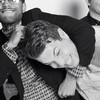Kim Il Sung Square. This is Pyongyang's most important square and a common gathering place for rallies, dances and military parades. The white dots on the ground are positioning marks.
Pyongyang's ice rink.
Entrance door of the demilitarized zone in the former village of Panmunjom where the armistice of the Korean war was signed between Korea and the United nations. The mosaic symbolizes North Korean's will of reunification.
Mosaics picturing Kim Il Sung and Kim Jong Il on the Jangdae Hill in Pyongyang.
Mangyongdae Children's Palace. This is a public facility in Pyongyang where children engage in activities, such as learning music, foreign languages, computing skills and sports. There is also a 2000 seat theatre to see the children's performances.
Mansudae Grand Monument with Kim Il Sung and Kim Jong Il's 20 meters tall statues in front of the sacred Mount Paektu's 70 meter long mosaic.
Shop selling local products in a cooperative farm close to Hamhung.
Ulim Waterfall, the 2001 sign was made in memory of Kim Jong Il's visit at that time and was sculpted to recreate his handwriting.
Grand People Study House entrance hall. This is Pyongyang's central library that was built to celebrate leader Kim Il-Sung's 70th birthday. It has a total floor space of 100 000m2 and 600 rooms.
Study room in the Grand People Study House in Pyongyang.
Pyongyang's Mansudae Art Theatre.
World map mosaic in International Children's Union Camp. The North Korean maps are always represented unified to symbolize the will of reunification.
Kim Il Sung's birth house in Mangyongdae-Guyok which considered North Korea's most sacred place
Pyongyang's maternity hospital entrance hall.
Pyongyang's Immortality tower to Kim Il Sung. This is a tower displayed in every city of the country dedicated to the perpetual memory of the DPRK President Kim Il Sung that says "The great leader, comrade Kim Il Sung and Kim Jong Il will stay with us for
The Korean Demilitarized Zone is the 250 kilometers long and 4 km wide's no man's land between the two Koreas with a concrete wall in the middle of it.
Pyongyang's national flower exhibition displaying the Kimilsungia and the Kimjongilia, the DPRK's national flowers.
Monument to the Party Foundation. This monument was constructed in Pyongyang under Kim Jong Il's will to mark the 50th anniversary of the founding of the ruling Korean Workers Party.
The Ryugyong Hotel with a height of 330 meters, is by far the largest structure in North Korea. The construction began in 1987 and is still ongoing.
